It was rather hot a month ago. In fact, the temperature record for the UK was clearly broken on the 16th of July 2022. Even with my ten gallon sceptics’ hat on, I could not dispute that. On the face of it, the 40.3°C recorded on the 19th of July this year was quite remarkable.
Now, in Denierland I did dispute the previous record of 38.7°C, set in July 2019 at the Cambridge Botanic Garden – sort of. I accepted it as a true record of how hot it was that day where people live – but questioned whether the record could be a true representation of how hot the UK would have been that day, in the presence of anthropogenic CO2 but in the absence of anthropogenic habitat alteration. That is to say, I doubted whether a temperature station in that very location but set in the original wildwood that covered the UK from stem to stern would have recorded the same value as the temperature station in the real Cambridge Botanic Garden in the real UK in 2019.
The same applies to the new 40°C record. It’s a true representation of what people experienced that day. It is not necessarily a direct measurement of climate change via CO2 emissions.
The record, it should be noted, was taken by RAF Coningsby in Lincolnshire. But five places recorded 40°C, as reported by Paul Homewood on the day itself (these records may have been revised, I do not know).
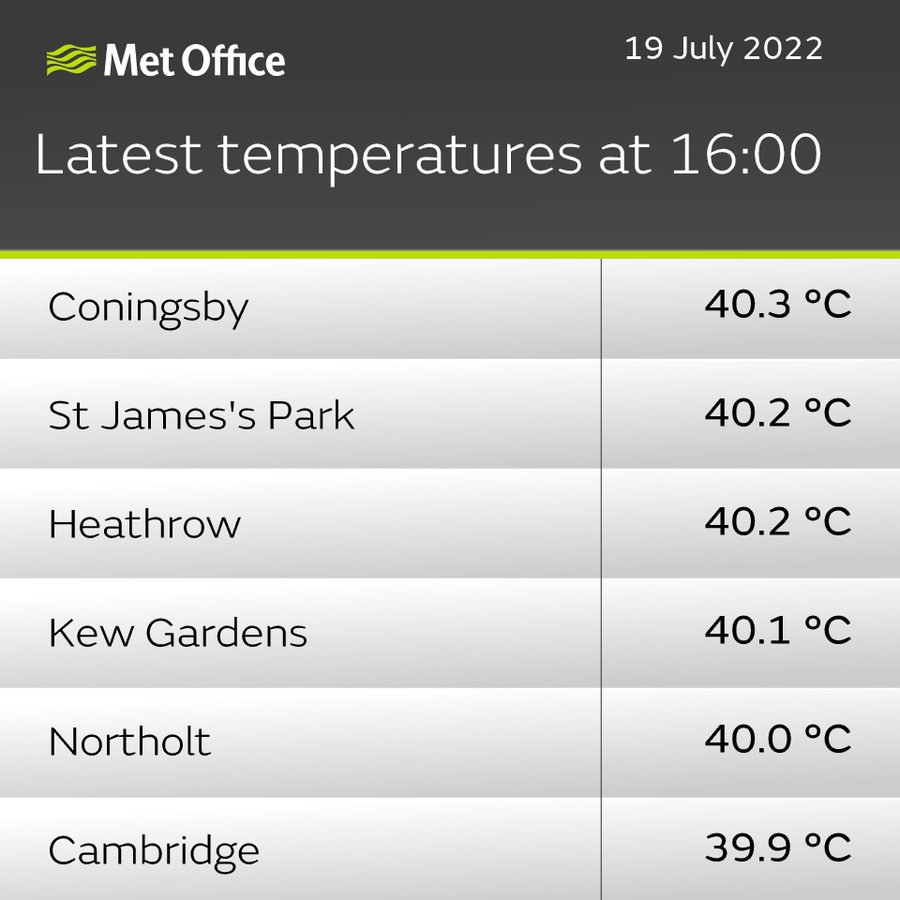
I would have been more than happy to let this stand without saying a word, right up until the point when the BBC began to browbeat us once again. Their headline:
UK heatwave: Five common myths debunked
“Debunked” is a kind of arrogant word that should not be used casually. If your intent is to demean your opponent, and you really have no sense of honour, then by all means use it. In any case its usage here is spare. “UK heatwave: five common myths” was sufficient. And if you debunk, you had better be sure your debunk is correct. Otherwise you end up showing that your priority is winning the argument, not ensuring that the facts are known. The article has already been mentioned at Cliscep, by John here and Mark in Open Mic.
Of the five “myths” presented by the BBC, I want to concentrate on #2, which like the others is enclosed in snark quotes just in case the reader might think the proposition is believed by the writer:
‘Runway temperatures are making it hotter’
The Met Office was accused of manufacturing and manipulating the record-breaking temperatures, because some were recorded at Heathrow. Some suggested heat emitted from the airport’s runway had skewed temperatures.
Temperature readings in the UK are taken from standardised weather stations, which have to meet specific criteria and are maintained and inspected by specialist teams.
Although some weather stations are located at airports, temperature readings are taken from thermometers in a Stevenson screen, which is a white slatted box with its door facing north.
The locations of these are also standardised, positioned over level grass and away from concrete or hardstanding wherever possible, which minimises the influence of man-made surfaces, like airport runways.
The Met Office also measures temperatures of the soil, ground and water in places too.
Now, if you want to argue that runways are not skewing the readings, it would be better to simply point to the fact that the records are not at runways. However, of the top 5, one is Heathrow and the other two are RAF bases with runways. That’s quite a strike rate.
What about those “specific criteria”? Perhaps the BBC debunker could have actually investigated, in an open-minded way, whether those 5 stations do in fact fulfil those criteria? Ya know, engage in a disinterested search for truth rather than a search for ways to get the deniers to shut the **** up once and for all?
Luckily this correspondent decided to do the work of the BBC’s debunker for them. So: just how good are these sites? One would hope that those crowing about records would first make damn sure that the sites where the records were made were beyond reproach, even by the most denialist deniers, the ones with the ten gallon sceptics’ hats. Are they?
WMO siting classification
The WMO classifies weather stations based on a range of criteria, from Class 1 (very good) to Class 5 (terrible). The criteria can be obtained here.
To summarise the relevant criteria:
Class 1
A source of heat (or expanse of water) is considered to have an impact if it occupies more than 10% of the surface within a circular radius of 100 m surrounding the screen, makes up 5% of an annulus of 10–30 m, or covers 1% of a 10 m radius area.
Class 2
A source of heat (or expanse of water) is considered to have an impact if it occupies more than 10% of the surface within a radius of 30 m surrounding the screen, makes up 5% of an annulus of 5–10 m, or covers 1% of a 5 m radius area.
Class 3 (additional estimated uncertainty added by siting up to 1 °C)
A source of heat (or expanse of water) is considered to have an impact if it occupies more than 10% of the surface within a radius of 10 m surrounding the screen or makes up 5% of a 5 m radius area.
Class 4 (additional estimated uncertainty added by siting up to 2 °C)
(a) Close, artificial heat sources and reflective surfaces (buildings, concrete surfaces, car parks, etc.) or expanse of water (unless significant of the region), occupying:
(i) Less than 50% of the surface within a 10 m radius around the screen;
(ii) Less than 30% of the surface within a 3 m radius around the screen;
Class 5 (additional estimated uncertainty added by siting up to 5 °C)
Coningsby
Here is the met station (these and subsequent snips from Google), with 10, 30 and 100 m rings (relevant to defining Class 1 and Class 2 sites):
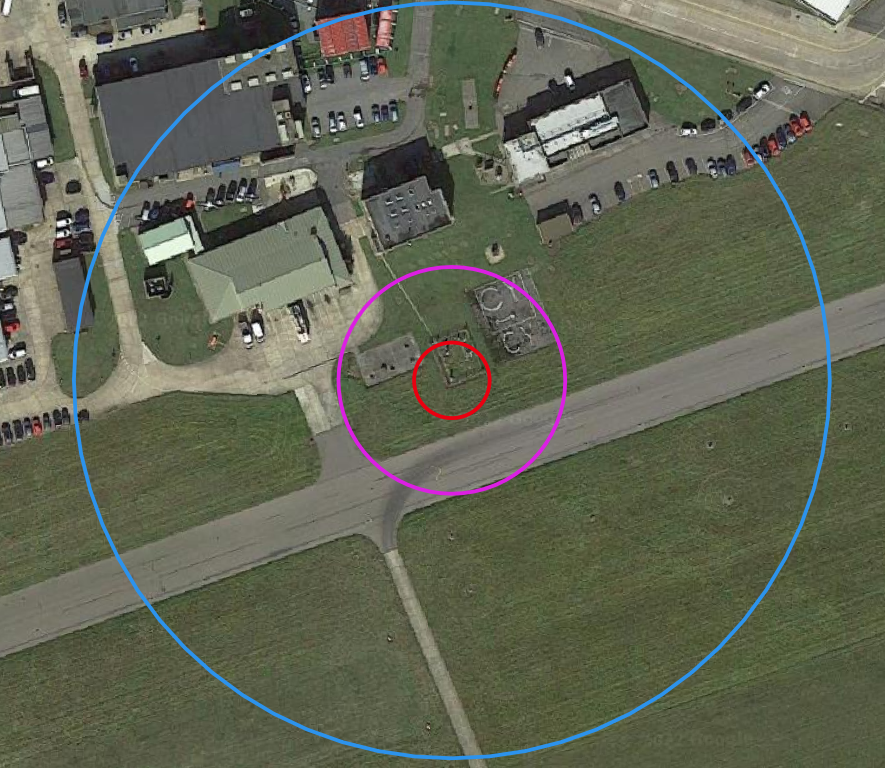
Conclusion: Class 3. Fails Class 2 because of the hardstanding within the 30m radius.
St James’s Park

Conclusion: Class 4. The metalled path is within 10 m.
Heathrow:
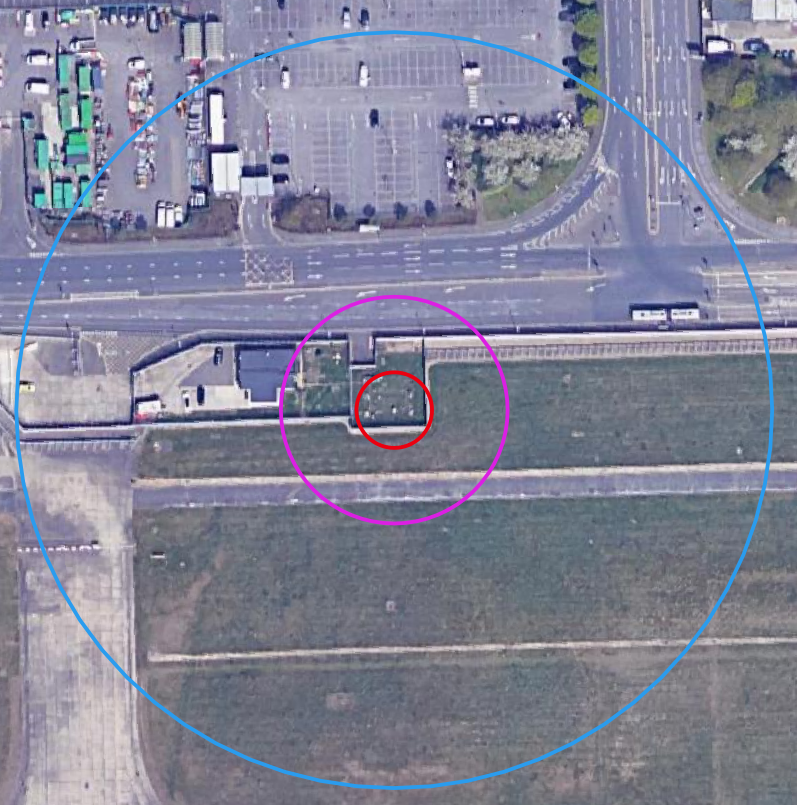
Conclusion: Class 3. Significant hardstanding within 30 m. Note: it looks as if the weather station has been surrounded by a solid fence.
Kew
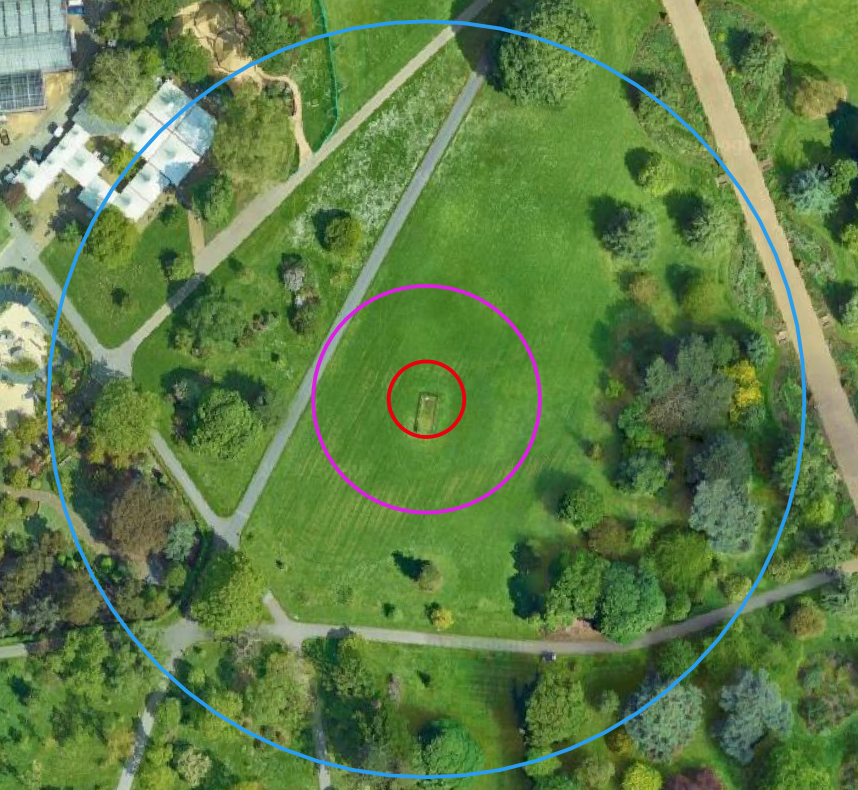
Conclusion: Close to Class 1, definitely not worse than 2. The children’s play area at lower left looks to be astroturf. There’s a cafe and some metalled paths. Putting it together the artificial surfaces total >10% within a 100 m radius, which would make it Class 2. Note: the children’s play area is fairly recent, and replaced natural ground with trees. This therefore has slightly contaminated the station.
Northolt
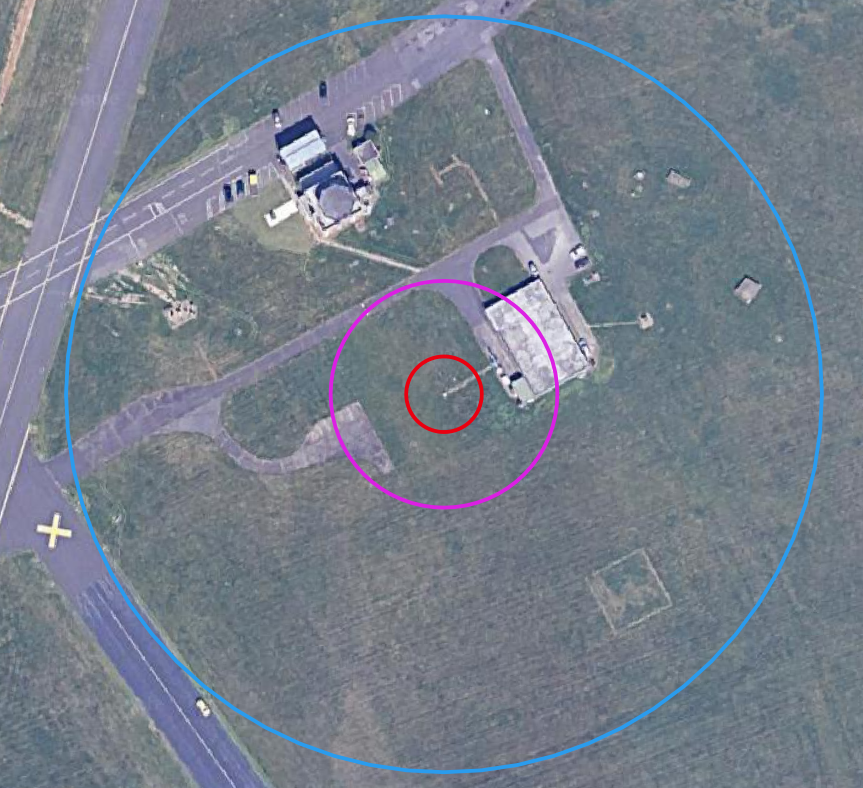
Conclusion: Class 3. Significant hardstanding within 30 m. The empty square at bottom looks like the former location of the weather station, but I can’t be sure. If so it was better before.
Of the five stations exceeding 40°C, only one is close to being “pristine” – Kew Gardens. And it is perhaps unnecessary to add that even Kew is in the middle of a large urban area. Caveat: I might have have mistaken the locations of the weather stations. Google Earth is very good, but it’s sometimes not obvious where the weather station is.
Harpenden
At this stage it is worth making a comparison with another site, this one that ticks the boxes and definitely meets the WMO criteria for Class 1: Harpenden. This site replaced the Cambridge Botanic Garden as a representative station for the Central England Temperature series. There are no buildings and no hardstanding within 100 m.
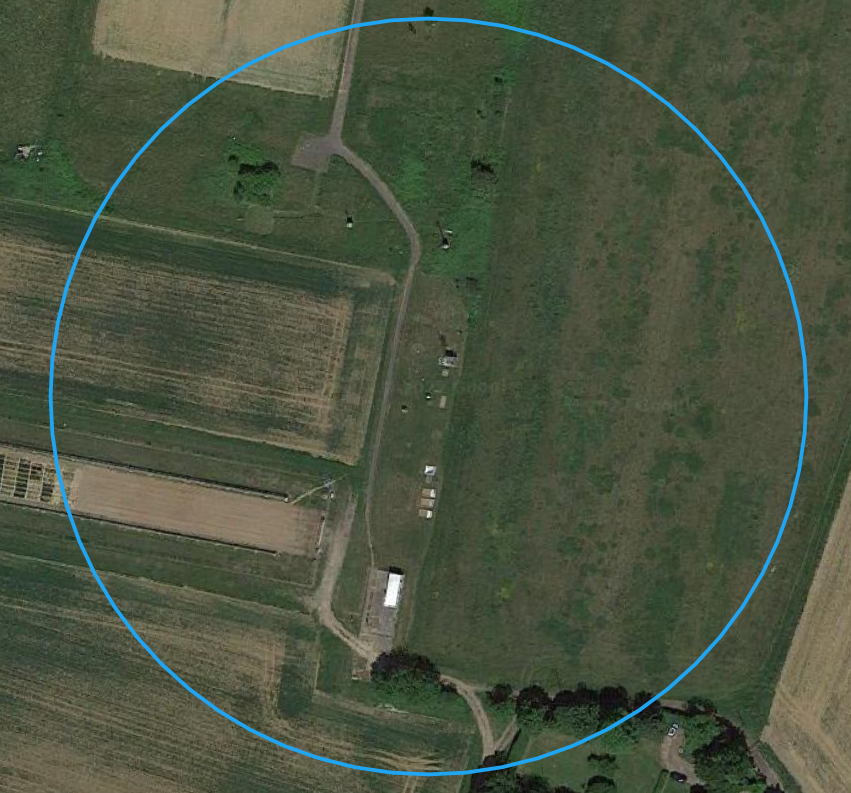
A sceptic might quibble about the qualities even of Harpenden, despite it qualifying as a Class 1 station. That is (i) because a set of arable fields are not representative of the pristine island that existed before wholesale forest clearance and (ii) the site is not far north of the great metropolis, and might receive pre-warmed air from there on a southerly breeze. However, the difference in temperature achieved is notable. I took these snips quite shortly after the record was announced, as you can tell from the time that the data is cut off. Both taken from the Met Office’s WOW. First, Coningsby, capping out at 40.3°C:
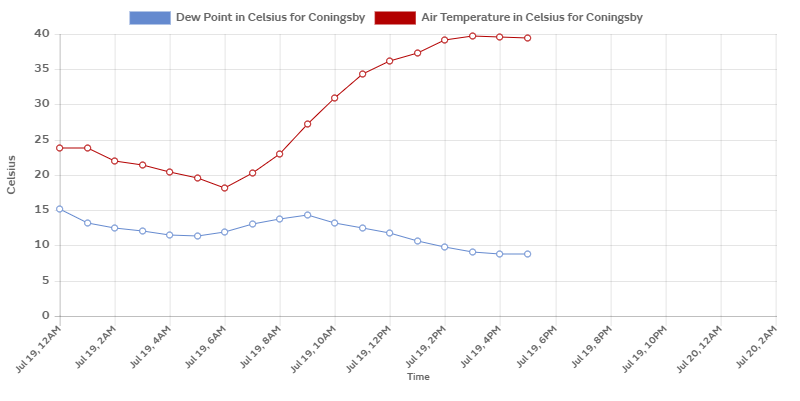
Next, Harpenden (the Rothamsted research station there), capping out at 37.8°C:
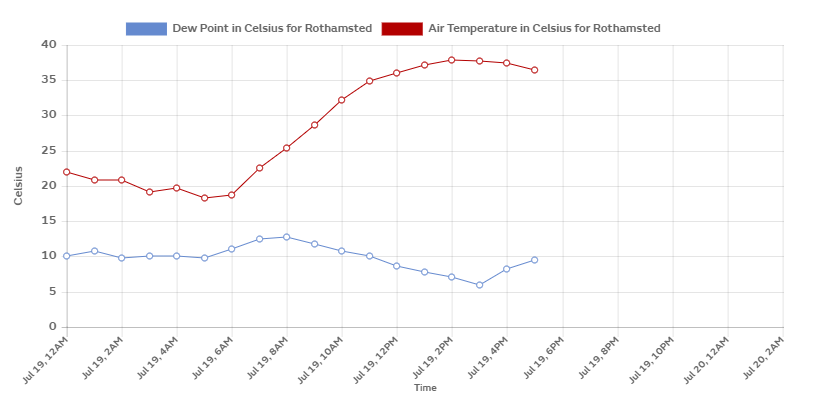
The day before the record, Radio 4’s The World at One was trailing, not 40°C, but 43°C. First the figure was given as a forecast, but that nuance was soon forgotten as Sarah Montague began asking learned guests: is this the new normal?
43°C, it need not be said, was way off the mark, and the time to discuss the record was after it had been achieved, not before.
Conclusion
The top score of 40.3°C came from a site of Class 3, with a 1°C variation from true. The question remains as to exactly how valid that record is.
Finally, I present the Met Office’s conception of what a weather station is supposed to look like. Doesn’t look a lot like an airport.

Featured image:
A frame from the BBC forecast of 16th July, showing climate change over the UK and Western Europe, and nothing much to see happening to the east of there.
Jit,
What part of ‘specialist teams’ did you not understand? 🙂
Leave poor old Merlyn alone. She’s only trying to do her job and her job is not to question what she has been told to say.
LikeLike
“And if you debunk, you had better be sure your debunk is correct.”
How very true. At the risk of taking this thread O/T, I’d like to remind everyone about the events surrounding the so-called Myth #1 (‘Weather maps are alarmist’).
It started when Aidan McGivern tweeted to draw attention to a ‘ridiculous comparison’ that deniers were making between old style graphics and a new style temperature map used by the Met Office. Aiden claimed that the temperature map doing the rounds on social media was obviously faked and this was a good example of the devious tactics that deniers resort to all the time. This accusation was then shown to be false when someone found the original posting of the weather map concerned — and it turned out it originated from the Met Office! That’s what you call debunking. And where was Merlyn whilst all of this was going on?
In the meantime Aiden had tried to pull the wool over everyone’s eyes by referring to changes necessary to help out those with colour blindness. This involves adoption of a Colorbrewer palette so that red/green comparisons are avoided. But that was never the issue for the ‘deniers’. The problem was to do with the fact that deep hues that had been used to represent 39c were now being used to represent 29c. This much was apparent by examining the examples of authentic maps that Aiden had himself tweeted.
Accentuating hues does not help the colour blind, it just helps the cause, and by tweeting the ‘correct’ weather maps Aiden had accidentally managed to debunk himself. And where was Merlyn whilst all of this was going on?
When all of this was discussed here on Cliscep earlier this year (see ‘Fiery Maps and Climate Change’), I posted the following comment:
“I now look forward to a Reality Check from one of the BBC’s intrepid climate disinformation specialists.”
And now here we have it, with Merlyn repeating the same lame, irrelevant smokescreen emitted by Aiden. Do you think Merlyn has even heard of Colorbrewer and the real reason it is used?
Now I’ve got that off my chest, let’s get back to runways and weather stations.
LikeLiked by 2 people
Who is the author of this excellent article?
(Since cliscep is a collaborative effort, it would be best if y’all would make a practice of always “signing” your articles with bylines. Please?)
LikeLike
“Who is the author of this excellent article?”
Some say he was delivered prematurely by a midwife who used a hockey stick.
Some say his adjectives are secretly funded by the Koch brothers, but not the nouns.
Some say he has a mole on his shoulder that he calls his little Greta.
All we know is that he’s called The Jit.
LikeLiked by 1 person
Jit, many thanks for doing that. The BBC’s propaganda is increasingly obviously just that – propaganda.
The ‘debunk’ relating to the relationship between temperature records and airports/runways irritated me greatly at the time. We are told that the connection is a myth, when patently it’s fact, as the BBC ‘debunk’ effectively acknowledges , by telling us that the use of a Stevenson screen “usually” “minimises” the influence of manmade surfaces. Usually isn’t the same as always. Minimises isn’t the same as eliminates.
LikeLiked by 1 person
Specialist teams, Mark. You’re forgetting the specialist teams.
LikeLike
John, not remotely O/T. I might have talked about #1 through #5 but had neither the will nor the time. In any case you’ve now done a better and more concise job on #1 than I could have.
I suppose we should not expect young (I presume) journalists in the BBC to produce fact checks that go against the zeitgeist. It’s nevertheless disappointing.
Dave, are author names not visible to you? Immediately below the title on every post. (Perhaps they don’t appear on a phone?)
LikeLike
Of some interest, in my little South Shropshire Market town, during the last week my temperature readings have been 3 degrees C lower than those forecast by the MO and BBC!
Thighest I’ve rever recorded was 32C in 2002 and when it was 40+ at Heathrow it was 30.1 here (hardly a record).
LikeLike
Then there are those hot city nights. All that concrete………….
https://agupubs.onlinelibrary.wiley.com/doi/10.1029/2021GL095678
LikeLike
Jit,
I notice that the highest temperatures recorded during this last heatwave were attributed to the Charlwood weather station. From what I can see, it is located about 35m from the main road into Crawley. What does that imply as far as its classification is concerned? Perhaps of more interest is the fact that it is about 1000m from the end of the runway at Garwick Airport and directly under the flightpath. Do you think that is an issue?
LikeLike
John, I see the station you are looking at. The road probably doesn’t cover >10% of the ground within a 100 m radius, so it’s probably Class 1. Looking back in time on Google Earth, the station wasn’t there at all in 2001. It’s visible in 2005, and it looks like some bushes are growing up immediately south of it that might cast shade at times of year with low sun angles, which would make it biassed low at those times. It should not be so close to a hedgerow, which should introduce a bias in the other direction by limiting air flow?
I can’t see the weather station at the airport, so can’t compare it with that. If we actually had the data, we could test for the effect of air traffic – I’m not quite sure how, but the Covid lockdown might provide an angle.
LikeLike
Crowcatcher, as I noted up top, Heathrow might be particularly bad. To judge from the satellite pic, it looks as if the weather station has a solid fence around it, not chainlink.
Are you up a hill? There’s the approximate 1 degree per hundred metres of elevation to consider.
LikeLike
Jit:
I have a small screen iPhone (an iPhone SE, the same screen size as the original iPhone). On that the author is visible on all posts on the Cliscep home page and after clicking on the post.
That said, I did like John’s allusion to The Stig.
LikeLike
No name, just “Jit”.
Google reports:
LikeLike
Dave, I see what you are getting at. The fact is, I’m working towards first name recognition.
(That is a lie. JIT is formed of my initials, and is what I have been mostly called since schooldays. Eventually I stopped all-capping it; hence “Jit.” Pity it is also “Just in Time” and a style of music. It also means either “warrior” or “king” according to a former colleague whose name was Ranajit, which he said meant “warrior king.” I can’t remember which word meant what. If you hover over my gravatar, you will see the cover of a book wot I rit, and a fuller name there. I keep meaning to amend the description to say “Just some guy.”)
LikeLike
Jit – a bit O/T but from your “Featured image: A frame from the BBC forecast of 16th July, showing climate change over the UK and Western Europe, and nothing much to see happening to the east of there.”
I notice that it shows north Africa average & colder mostly, wonder where the heat from there went ?
LikeLike
More to the point Jf, hot weather in Europe and the British Isles commonly is described as having originated in the Sahara Desert and has been driven northwards. Sometimes there is even red dust in those winds. But not so this time. If anything heat from the Iberian Peninsula is warming Morocco. Does global warming (or any of its multitudinous alternatives) predict this?
LikeLike
Jit,
Thank you for your question.
When I recorded the 32C I happened to be at the cricket in Worcester where it was reported as 34C.
I live in the highest house in my little market town about 60 metres higher than the river. A few years ago I did a rough check with my thermometer by taking it down there and measured about 1.5C higher than at home, so, still lower than the Met forecast.
LikeLike
In the Daily Sceptic, fresh suspicions about this July’s records: https://dailysceptic.org/2022/11/27/fresh-doubts-emerge-about-40-3c-u-k-temperature-record-next-to-airfield-runway/
LikeLike
“Climate Change Scandal in Australia Heating Up”
https://dailysceptic.org/2023/04/17/climate-change-scandal-in-australia-heating-up/
LikeLike
“Climate change: Spain breaks record temperature for April”
https://www.bbc.co.uk/news/science-environment-65403381
Can you guess where the new record was set? There’s something of a theme developing here, so there are no prizes for guessing:
I don’t deny that it’s been unusually warm this month in Spain, but then it’s been unusually cold where I live this month. The log burner is on as I write. It’s called weather.
LikeLiked by 1 person
Persistence paying dividends? Conspiracy theories becoming mainstream? WordPress alerted me to this Daily sceptic article, presumably because it links here:
https://dailysceptic.org/2023/06/28/exclusive-three-typhoon-jets-landed-next-to-measuring-device-when-britains-record-temperature-of-40-3c-was-recorded/
LikeLike
Jit, I wonder why WordPress didn’t alert you to my own linking to your article here in a piece I wrote yesterday, prior to the Daily Sceptic publishing its criticism of the Coningsby 40.3C ‘record’.
https://jaimejessop.substack.com/p/psy-op-wars-the-british-are-being
LikeLike
Jaime, it was stuck in pending, thanks to WordPress. I released the pingback earlier this morning.
LikeLiked by 1 person
I tried commenting on that DS article only to discover that they require a financial contribution before allowing you to do so! Sod that. Not really conducive to open discourse.
LikeLike
Mark/Jaime
I received two emails re: Daily Sceptic. One to ask me to moderate the pingback, and another notifying me of the pingback comment (after Mark had released it?). I have had no mails at all about Jaime’s, which is mystifying.
LikeLiked by 1 person
“It is mystifying indeed.”
I am of course following, as always, the prayers and responses for the solemn gathering of WordPress admins.
(They said we don’t have a prayer but that’s quite wrong. I have many, some more desperate than others.)
LikeLiked by 1 person
Jit, I didn’t receive a message about it, but I noticed it when I was checking if anything needed to be released from Spam. Apologies from me, it was on your thread, and I should have emailed you to let you know, though I guessed that on this occasion you wouldn’t mind.
LikeLike
Mark/Jit,
Makes me wonder if WordPress are downgrading notifications from Substack.
LikeLike
Update: Notalot identifies the met station for Northolt as in a different place & confirmed with streetview. I will have to revise my score for this one (it’s probably worse). And it looks like I had the location in the head post in the wrong place anyway – the little compound west of the control tower was where I supposed the station to be, I think. Google Earth is good for a lot of things, but when out of range of streetview, interpretation is difficult.
LikeLiked by 1 person